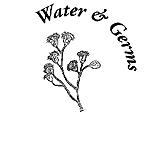
Introduction
1. What are germs?
2. Getting germs
3. Germ environment
4. Germ travel
5. Symptoms
6. Water's role
7. Water suppliers
8. Rules
9. Conclusion
Diseases & pathogens
Note on E. coli
A Final Note On E. Coli"The rod-shaped bacteria known as E. coli are part of the normal flora of our intestines.... The vast majority of E. coli strains are harmless to most humans most of the time.... There are five groups of E. coli whose toxins cause diarrhea of various levels of severity. Some are the culprits behind traveler's tummy or "Montezuma's revenge." One country's flora are different from another's, so tourists may suffer a kind of poisoning until their immune systems adapt to newly imbibed bacteria.
"The worst
E. coli bacterium, E. coli 0157:H, a mutation discovered
in 1982 that has at least 62 subtypes, causes hemorrhagic colitis, an
acute bloody diarrhea much like dysentery that can kill weak victims.
Undercooked beef and raw milk are the microbe's favorite homes.... In
1991, twenty-seven people in Massachusetts were struck with ECO157 infection
after drinking cider made from apples grown on trees fertilized with manure."
| [Note
about apple cider: The E. coli did not infect the apples on
the tree. Cider is often made from "drops," apples that have fallen
to the ground. If the "drops" come in contact with manure applied
to the trees, contamination can occur.]
|